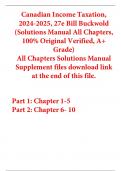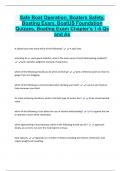Canadian Income Taxation,
2024-2025, 27e Bill Buckwold
(Solutions Manual All Chapters,
100% Original Verified, A+
Grade)
All Chapters Solutions Manual
Supplement files download link
at the end of this file.
Part 1: Chapter 1-5
Part 2: Chapter 6- 10
, Part 2: Chapter 6- 10
CHAPTER 6
THE ACQUISITION, USE, AND DISPOSAL OF DEPRECIABLE PROPERTY
Review Questions
1. Under the income tax system, neither capital expenditures nor amortization/depreciation can be
deducted when income for tax purposes is being calculated. The same system imposes an
arbitrary and uniform method of cost allocation based on the type of asset used. Explain the
reason for this significant departure from generally accepted accounting principles in arriving at
income for tax purposes.
2. Can an individual who earns employment income claim a deduction for CCA in arriving at income
from employment? If yes, are any restrictions imposed?
3. A business acquires land for a customer parking lot and incurs the following costs:
Land $50,000
Legal fees to complete purchase agreement 2,000
Legal fees in connection with obtaining a mortgage loan for the land 1,000
Small building for attendant 10,000
Exterior landscaping 2,000
$65,000
Briefly explain the tax treatment of these costs.
4. A business can obtain the right to use property through ownership or leasing. Briefly compare the
tax treatment of purchasing land and building with that of leasing land and building. Refer to both
the amount and timing of the related deductions for tax purposes.
5. What is the meaning and significance of the term “capital cost” of an asset?
6. Explain why the deduction of capital cost allowance is a “discretionary” deduction.
7. Depreciable properties are divided into a number of different classes, and a specific allocation
rate (CCA rate) is assigned to each class. Explain why this system is fair to some taxpayers, unfair
to others, and more than fair to others.
8. Briefly explain what is meant by the “pool concept” in the CCA system.
9. To what extent, if any, does the pooling concept inherent in the CCA system affect the tax
treatment of any gains and losses that occur on the disposition of depreciable property? In general
terms, explain when a gain or loss will occur.
10. Describe the possible ramifications of purchasing new depreciable property on the last day of the
current taxation year as opposed to the first day of the next taxation year (that is, one day later).
11. What is a leasehold improvement, and how does its tax treatment vary from the normal CCA
Copyright © 2024 McGraw Hill Ltd. 1
Review and Key Concept Questions Solutions Manual Chapter Six
, Buckwold, Kitunen, Roman and Iqbal, Canadian Income Taxation, 2024-2025 Ed.
treatment?
12. Taxpayer A leases a building for 15 years. Taxpayer B secures the right to lease a building for 15
years by signing a three-year lease with two renewable option periods—one for 2 additional years
and a second for 10 years. Both A and B incur leasehold improvement costs at the beginning of
the lease. Explain the tax treatment of the leasehold improvements to both A and B. Which
taxpayer has signed the better lease? Explain.
13. If the sale of an asset results in income from a recapture of CCA, is it necessary to acquire another
asset in the same year in order to avoid the recapture? Explain.
14. Explain the tax consequences, if any, when an individual proprietor of a new business transfers
personal-use office furniture for use in the business.
15. Describe two alternative tax treatments that may apply when a business purchases a franchise.
16. Explain why a businessperson might view the cost of a $100,000 building as being significantly
higher than the cost of a $100,000 delivery truck. Make a cost comparison, assuming the taxpayer
is subject to a 45% tax rate and can invest funds to generate an after-tax cash return of 9%.
(Assume the building qualifies for the 6% CCA rate).
Copyright © 2024 McGraw Hill Ltd. 2
Review and Key Concept Questions Solutions Manual Chapter Six
, Buckwold, Kitunen, Roman and Iqbal, Canadian Income Taxation, 2024-2025 Ed.
Solutions to Review Questions
R6-1. The determination of amortization for accounting purposes is extremely subjective, requiring an
estimate of an asset's useful life, annual usage, and salvage value. Consequently, assets of a similar
type are subject to a wide range of amortization rates and methods even though they may be used
for similar purposes in similar business types.
The arbitrary capital cost allowance system overcomes the consequence of subjectivity associated
with amortization methods and eliminates the need for an excessive amount of assessment review
by CRA. In addition, it treats all assets within a general category in the same manner providing equal
treatment to each taxpayer. In some respects, the system is unfair because it gives no consideration
to the way in which different businesses use similar assets and, therefore, the CCA system may not
conform to economic reality.
R6-2. Yes, individuals who are employed may claim capital cost allowance in certain circumstances. For
employees earning employment income, CCA can be claimed only on automobiles, aircraft (and
musical instruments). Employment income cannot be reduced by CCA on any other type of asset
even if it is used in the performance of employment duties [ITA 8(1)(j) & (p)].
R6-3. Although total cost of acquiring and preparing the land for use is $65,000, the several component
parts are treated differently.
Land ($50,000) is a capital asset because it has a long- term and enduring benefit and is not
deductible as an expense. In addition, it does not qualify as depreciable property and no capital
cost allowance is available.
Legal fees ($2,000) to complete the purchase agreement are capital in nature, associated with the
cost of the land. The fees are not deductible but are merely added to the land cost [ITA 18(1)(b)].
Legal fees ($1,000) in connection with obtaining mortgage financing are also a capital item.
However, by exception, the expense qualifies as a cost incurred to issue debt and is permitted to
be deducted over five years at 1/5 per year [ITA 20(1)(e)].
The small building ($10,000) is a property separate from the land. It is a capital expenditure and
not deductible. However, the building qualifies as Class 1 property and is subject to CCA at 4%,
declining balance. If the building was not used prior to March 19, 2007, and is placed in a separate
Class 1, the CCA rate will increase by 2% to 6%.
Exterior landscaping ($2,000) is a capital item and not normally deductible. However, by exception,
ITA 20(1)(aa) permits the full amount to be deducted when paid.
R6-4. If the property is purchased, the cost of the land cannot be deducted for tax purposes. The building
cost can be deducted as capital cost allowance at 4%, 6% or 10% annually declining balance.
In comparison, if the property is leased, a deduction for tax purposes is available for the land as
well as the building. The full amount of rent for the land and building is deductible in the year in
which it is incurred.
R6-5. The term capital cost refers to the total cost amount associated with the acquisition of a
Copyright © 2024 McGraw Hill Ltd. 3
Review and Key Concept Questions Solutions Manual Chapter Six





